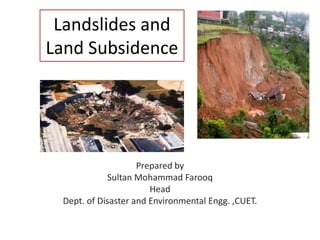Landslides occur when masses of rock, earth, or debris move down a slope. They are caused by a combination of factors that increase shear stress or decrease shear strength, such as heavy rainfall, earthquakes, erosion, and human activity. Landslides can be classified based on material, type of movement, speed, and other attributes. Common types include rotational slides, translational slides, rock falls, debris flows, and soil creeps. Landslides pose risks to infrastructure, property, and human life. The hilly regions of Bangladesh are particularly vulnerable due to factors like deforestation, construction activity, and heavy monsoon rains.













































































